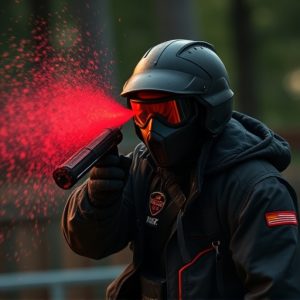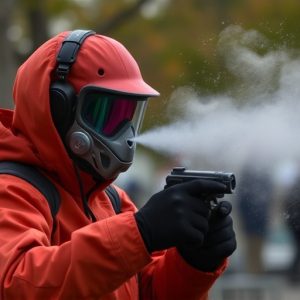Decoding Pepper Spray’s Impact and Safe Use for Self-Defense
Pepper spray is a potent non-lethal self-defense tool containing oleoresin capsicum that causes int…….
Pepper spray is a potent non-lethal self-defense tool containing oleoresin capsicum that causes intense pain and temporary incapacitation by binding to pain receptors in the eyes and respiratory system. Its effects include severe eye irritation, causing immediate tearing, redness, and swelling, which can lead to temporary blindness if not promptly flushed out. The impact on vision is generally reversible but can be prolonged or exacerbated by factors like environmental conditions and individual sensitivity. It's crucial for users to understand the potential visual consequences of using pepper spray to ensure its responsible use. Law enforcement-grade sprays have higher concentrations of active ingredients, enhancing their effects, but both civilian and law enforcement must handle them with caution due to the risk of causing harm. The legal use of inflammatory sprays like pepper spray is regulated, with strict guidelines in place to prevent severe outcomes such as permanent blindness. Users are advised to adhere to local laws and consider alternative self-defense methods, like laser devices or personal alarms, that offer protection without the risk of causing long-term eye damage. The discourse around whether pepper spray can lead to blindness is part of a broader conversation on the ethical and legal use of such tools, emphasizing the importance of selecting a self-defense mechanism that aligns with both personal safety needs and legal requirements.
Pepperspray is a potent self-defense tool, widely recognized for its ability to incapacitate assailants. This article delves into the mechanisms behind pepper spray, elucidating its effects on vision and potential for temporary visual impairment, addressing concerns such as “Can pepper spray blind you?” We explore its strength, safety considerations in deployment, and the legal framework governing its use. Additionally, we compare it with alternative defense options that offer protection without posing a significant risk to vision. Understanding these aspects is crucial for those considering pepper spray as part of their personal safety strategy.
Understanding Pepper Spray: Mechanisms and Effects on Vision
Pepper spray, a form of non-lethal self-defense, is widely recognized for its immediate and potent effects on the eyes and respiratory system. When deployed, the active ingredient, oleoresin capsicum, comes into contact with mucous membranes, causing a burning sensation that can temporarily incapacitate an assailant. The compound binds to pain receptors, triggering a cascade of neural signals that result in intense pain, tearing, and a reflexive closure of the eyelids, which can last from 15 to 45 minutes or more, depending on wind conditions, spray concentration, and individual sensitivity. The effects on vision are particularly noteworthy as the irritant causes the eyes to become red and swollen, severely limiting visibility. Can pepper spray blind you permanently? Typically, the effects are reversible once the spray is washed out of the eyes with copious amounts of fluid, such as water or an eyewash solution. However, prolonged exposure or direct contact with the eyes without immediate flushing can lead to temporary blindness due to swelling and inflammation. It’s crucial for individuals using pepper spray to be aware of its effects and to follow proper protocols for washing away the substance to prevent prolonged exposure and potential damage. Understanding these mechanisms is essential for anyone considering pepper spray as a personal defense option, ensuring they use it responsibly and understand its impact on vision.
The Potency of Pepper Spray: How Strong is it, and Can It Cause Temporary Blindness?
Pepper spray, a potent self-defense tool, is formulated with capsaicinoid derivatives from chili peppers. These compounds create an intense irritant upon contact with the eyes, skin, or respiratory system of an attacker. The concentration of oleoresin capsaicin, the primary active component in pepper spray, can vary, with law enforcement-grade sprays typically containing higher concentrations than those designed for civilian self-defense. This high potency is what allows it to effectively incapacitate an assailant by causing a burning sensation that leads to temporary blindness. The effects of pepper spray on the eyes can cause uncontrollable tearing, intense pain, and swelling, which collectively impair vision for a few minutes to half an hour. This temporary visual impairment can be sufficient to allow a person to escape from a dangerous situation. It’s important to note that while pepper spray can indeed cause temporary blindness, it is a non-lethal tool designed to provide a temporary defense mechanism rather than cause permanent harm. Users should handle and use pepper sprays with caution and in accordance with local laws and guidelines.
Safety Considerations: Using Pepper Spray Responsibly to Avoid Unintended Consequences
When considering the use of inflammatory sprays, such as pepper spray, for self-defense, it’s crucial to understand both the effectiveness and potential risks. Pepper spray, a non-lethal self-defense tool, is designed to temporarily incapacitate an attacker by causing intense irritation to their eyes and respiratory system. While it can be an effective deterrent in dangerous situations, users must handle it with caution. Misuse or accidental discharge can lead to serious consequences, including harm to oneself, bystanders, or animals. It’s essential to recognize that aiming pepper spray directly at a person’s face can cause extreme pain and potentially blindness if used improperly. The potent chemicals in the spray are meant to be deployed as a last resort, in circumstances where personal safety is immediately threatened. Users must familiarize themselves with the proper techniques for deploying the spray, including understanding the wind conditions and potential scattering of the substance. Safety training and practice can mitigate the risks associated with its use. Therefore, responsible ownership and application of pepper spray are paramount to preventing unintended and harmful outcomes. Always adhere to local laws and regulations governing the use of such self-defense products, and consider enrolling in a certified safety course to ensure you know how to use it effectively and safely under pressure.
Legal Implications and Regulations Surrounding the Use of Pepper Spray
The use of inflammatory sprays, including pepper spray, is governed by a complex array of legal implications and regulations that vary by jurisdiction. Pepper spray, a non-lethal self-defense tool, contains oleoresin capsicum, which can cause intense irritation upon contact with the eyes, skin, or respiratory tract. Its deployment must be carefully considered within the context of self-defense and law enforcement practices. Legally, individuals are permitted to carry pepper spray in many regions for personal protection, provided it is used according to state or local laws. However, there are strict guidelines dictating the concentration, formulation, and capacity of the spray. The potential question of whether pepper spray can permanently blind someone is a critical aspect of these regulations. Authorities have established thresholds to ensure that the chemical compounds in pepper spray do not cause long-lasting damage when used as intended for self-defense. Misuse or excessive use of pepper spray can lead to legal consequences, including charges of assault or unlawful use of a weapon. Law enforcement officers, too, are subject to these regulations and must undergo training to employ such sprays effectively and legally during apprehension or crowd control scenarios. Understanding the legal boundaries of pepper spray usage is essential for both civilians and law enforcement to avoid legal ramifications that could arise from unauthorized or improper use. It is a tool intended for specific, limited circumstances where personal safety is at risk, and its use must always be in accordance with the law.
Alternatives to Pepper Spray: Effective Self-Defense Options with Less Risk to Vision
When considering personal safety measures, it’s common for individuals to explore alternatives to traditional pepper spray, particularly due to concerns about its impact on vision. While highly effective as a deterrent, pepper spray can temporarily blind an attacker by irritating their eyes. However, there are less risky options that still provide robust self-defense capabilities. One such alternative is the use of laser self-defense devices, which can incapacitate an assailant without causing permanent damage to their vision. These devices work by emitting a high-intensity beam of light directed at an aggressor’s eyes, creating an intense visual stimulus that disorients and deters attackers. Another option is a personal alarm, which, while not a physical defense mechanism, can effectively draw attention to your location, alerting bystanders or law enforcement to the threat you face. Stun guns are also a viable alternative, offering a non-lethal electric shock that can incapacitate an attacker without risking harm to their eyes. When selecting a self-defense tool, it’s crucial to consider local laws and regulations, as well as your own comfort and proficiency with the device. Each of these alternatives serves as a testament to the innovation in personal safety technology, providing effective options for individuals seeking to protect themselves while mitigating potential risks associated with certain defense mechanisms like pepper spray.


